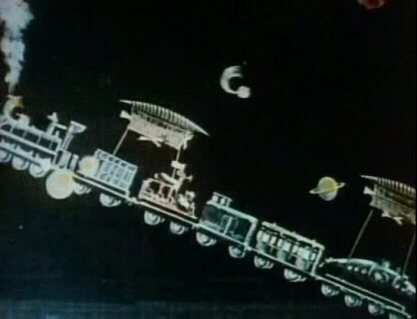Wagon Train to the Staaaaaars!
In 1904, a couple of years after his groundbreaking Le Voyage dans la Lune, Georges Méliès tried his hand at a more ambitious science fiction epic. Voyage à Travers L’Impossible (“A Voyage Across the Impossible” though more usually translated as simply “Impossible Voyage“), is around 20 minutes long, depending on whether or not you see the cheap version or the one with the bonus footage Méliès provided to exhibitors who paid extra. The concept of the deluxe 2-disc set has clearly been around a while. Voyage à Travers L’Impossible, in addition to being a longer film, is much more painstakingly hand-tinted. Where the previous film had a palette of grays, pale greens and blues, this Voyage blazes with gold and crimson. The result, while undeniably a special-effects extravaganza, is the first ever instance of a science fiction plotline suffering at the expense of its gosh-wow visuals.
And, as with the earlier film, Méliès drew on the novels of Jules Verne for his inspiration, but more specifically he roughly copied one of Verne’s own plays. The “Institute of Incoherent Geography,” headed by M. Mabouloff, ventures forth on an expedition around the world. They set out in a locomotive loaded with all sorts of nifty-looking craft, including a submarine, a couple of airships, and an “Impossible Carriage” which seems to be a sort of automobile. Reaching the Swiss Alps, they transfer to the automobile and promptly have a devastating road accident, sending everyone to the hospital. Ford Explorer, I guess.
Fully recovered from this inexplicable plot digression (maybe road accidents were thought to be a laff riot in 1904?), our heroes board the locomotive once more and it chugs away across the mountains. Higher and higher it goes, until it vaults into the stars. It zooms along through space, evidently held up by its twin airships, past a few charmingly animated comets and planetary systems and one obvious sparkler left over from Bastille Day. Mais non! Here comes the Sun, and we ain’t talking Beatles songs: it’s the Man in the Sun, who yawns so widely the Star Locomotive flies straight into his mouth. He gasps, he coughs, he vomits fire. Does he spit the ruined train out on the surface of Mercury? Despite most synopses insisting our heroes have crashed on the sun, it’s later clearly visible in the sky, so I’m going with Mercury.
The expedition members pick themselves out of the ruins of the train. This was the point where it dawned on me that there women among the members—another first for sci-fi films! I was also diverted to learn that the conical felt hat was actually worn by someone besides Chico Marx and Pagliacci. Our heroes and heroines wander around exclaiming over the scenery awhile before suddenly being overcome with the heat. Fortunately their boxcar full of glacier ice (???) survived the crash, so M. Mabouloff herds everyone into it and shuts the door. Too late, he realizes he ought to have gotten in, too, but when he opens the freezer door again he discovers all the other expedition members frozen in a block of ice. The first-ever instance of cryogenics in a film!
So the dude gets out (I’m not kidding) a couple of hay bales they brought along and, spreading them under the boxcar, sets fire to them. The crew thaws out, revived. Fortunately their submarine survived the crash, too. It’s not only a charming little copy of Señor Monturiol’s actual 1858 Ictineo II, it works as a space capsule! They climb in, plummet down to earth and deploy a parachute at the last minute to soften their sea landing—another first-time-on-film. Their undersea journey takes place in a cutaway version of the sub, which, I believe, is yet another first. Alas, the sub explodes and sends the expedition members sky-high once more, though this time they land safely in a harbor and are rescued by the cheering multitudes.
See? Lots of flashy tech, uneven plotting, zippo character development. Science fiction cinema had already become the creature we all know and love…
And yet, that little train is just so darned cute. Look at what it implies in self-confidence, for 1904. Man— er, Humanity—will travel across the Earth, into the Sky, and under the Sea. Not only that, we will have the foresight to bring along hay for any Star Cows we encounter, and plenty of ice for our champagne.











in oliver postgate’s animated clangers series, one episode features benign vegetarian beasties known as “space moos” — they’re basically blue cows with big long ears who save our heroes by eating a planet-full of accidentally planted flowers. perhaps the bales of hay are foresight for any space moos we encounter!